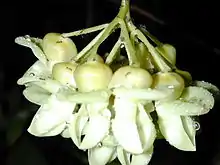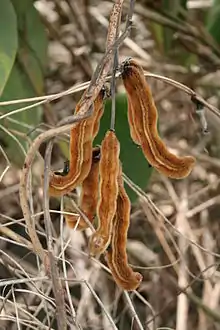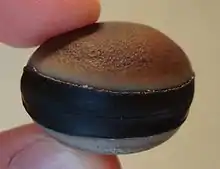Mucuna
Mucuna is a genus of around 100 accepted species of climbing lianas (vines) and shrubs of the family Fabaceae: tribe Phaseoleae and typically found in Tropical forests.
| Mucuna | |
|---|---|
 | |
| Mucuna gigantea flowers | |
| Scientific classification | |
| Kingdom: | Plantae |
| Clade: | Tracheophytes |
| Clade: | Angiosperms |
| Clade: | Eudicots |
| Clade: | Rosids |
| Order: | Fabales |
| Family: | Fabaceae |
| Tribe: | Phaseoleae |
| Genus: | Mucuna Adans.[1] |
| Species | |
|
Some 100, see text. | |
| Synonyms[1] | |
| |
The leaves are trifoliolate, alternate, or spiraled, and the flowers are pea-like but larger, with distinctive curved petals, and occurring in racemes. Like other legumes, Mucuna plants bear pods. They are generally bat-pollinated and produce seeds that are buoyant sea-beans. These have a characteristic three-layered appearance, appearing like the eyes of a large mammal in some species and like a hamburger in others (most notably M. sloanei) and giving rise to common names like deer-eye beans, donkey-eye beans, ox-eye beans, or hamburger seed.
The name of the genus is derived from mucunã, a Tupi–Guarani word for these species.[2]
Ecology
Some Mucuna species are used as food plants by caterpillars of Lepidoptera. These include Morpho butterflies and the two-barred flasher (Astraptes fulgerator) which is sometimes found on M. holtonii and perhaps others. The plant pathogenic fungus Mycosphaerella mucunae is named for being first discovered on Mucuna.
Uses


The pods of some species are covered in coarse hairs that contain the proteolytic enzyme mucunain and cause itchy blisters when they come in contact with skin; specific epithets such as pruriens (Latin: "itching") or urens (Latinized Ancient Greek: "stinging like a nettle") refer to this. Mucuna pod hairs are a common ingredient in itching powder. Other parts of the plant have medicinal properties. The plants or their extracts are sold in herbalism against a range of conditions, such as urinary tract, neurological and menstruation disorders, constipation, edema, fevers, tuberculosis, ulcers, and helminthiases like elephantiasis.[3] In an experiment to test if M. pruriens might have an effect on the symptoms of Parkinson's disease, Katzenschlager et al. found that a seed powder had a comparable, if not more favourable, effect as commercial formulations of L-dopa, although the trial only consisted of 4 people per test group.[4]
M. pruriens was found to increase phosphorus availability after application of rock phosphate in one Nigerian experiment.[5] M. pruriens was used in Native American milpa agriculture.
Mucuna seeds contain a large number of anti-nutritional compounds. The most important is L-dopa, which the digestive system of most animals confuses with the amino acid tyrosine, causing the production of defective proteins. Other anti-nutrients are tannins, lectins, phytic acid, cyanogenic glycosides, and trypsin and amylase inhibitors, although all these can be removed by long cooking.[6] M. pruriens may also contain chemicals such as serotonin, 5-HTP, nicotine and the hallucinogenic tryptamines 5-MeO-DMT, bufotenine and dimethyltryptamine,[6][7] Mucuna is not traditionally consumed as a food crop, but some preliminary experiments have shown that if the anti-nutrients are removed or at least brought down to safe level, the beans can be fed to livestock or people. The L-dopa content is the most important and difficult toxin to get rid of. The seeds must be extensively processed before they can be safely eaten. Diallo & Berhe found the best method was to crack open the seeds and soak them in constantly running fresh water such as under an open faucet for 36 hours, or to put them in a bag and leave in a flowing river for 72 hours, before cooking them for over an hour. Over a thousand people in the Republic of Guinea were fed a meal of Mucuna (mixed with many other ingredients) with no obvious ill effects.[8]
Species




|
|
Formerly placed here
- Canavalia mattogrossensis (Barb. Rodr.) Malme (as M. mattegrossensis Barb. Rodr.)
- Psophocarpus scandens (Endl.) Verdc. (as M. comorensis Vatke)[11]
References
- "Genus: Mucuna Adans". Germplasm Resources Information Network. United States Department of Agriculture. 2007-10-05. Archived from the original on 2015-09-24. Retrieved 2011-02-23.
- Quattrocchi, Umberto (2000). CRC World Dictionary of Plant Names. 3 M-Q. CRC Press. p. 1738. ISBN 978-0-8493-2677-6.
- Oudhia (2002)
- Katzenschlager et al. (2004)
- Vanlauwe et al. (2000)
- Szabo, N. J. (April 2003). "Indolealkylamines in Mucuna species" (PDF). Tropical and Subtropical Agroecosystems. 1 (2–3): 295–307.
- Erowid (2002): Mucuna pruriens. Created 2002-APR-22. Retrieved 2007-DEC-17
- Diallo & Berhe (2003)
- Aitawade, Makarand M.; Yadav, S.R. (2012). "Mucuna sanjappae, a new species from the north-Western Ghats, India". Kew Bulletin. Royal Botanic Gardens, Kew. 67 (3): 539–543. doi:10.1007/s12225-012-9369-1. S2CID 46121626.
- ILDIS (2005)
- "GRIN Species Records of Mucuna". Germplasm Resources Information Network. United States Department of Agriculture. Retrieved 2011-02-23.
Sources
- Diallo, O.K.; Berhe, T. (2003). "Processing the Mucuna for Human Food in the Republic of Guinea" (PDF). Tropical and Subtropical Agroecosystems. 1 (2/3): 193–196. Archived from the original (PDF) on 2007-09-26.
- International Legume Database & Information Service (ILDIS) (2005): Genus Mucuna. Version 10.01, November 2005. Retrieved 2007-DEC-17.
- Katzenschlager, R.; Evans, A.; Manson, A.; Patsalos, P.N.; Ratnaraj, N.; Watt, H.; Timmermann, L.; van der Giessen, R.; Lees, A.J. (2004). "Mucuna pruriens in Parkinson's disease: a double blind clinical and pharmacological study". Journal of Neurology, Neurosurgery, and Psychiatry. 75 (12): 1672–1677. doi:10.1136/jnnp.2003.028761. PMC 1738871. PMID 15548480.
- Oudhia, Pankaj (2002): Kapikachu or Cowhage (Mucuna pruriens) Crop Fact Sheet. Version of 5-9-2002. Retrieved 2007-DEC-17.
- Vanlauwe, B.O. (2000). "Nwoke, C.; Diels, J.; Sanginga, N.; Carsky, R.J.; Deckers, J. & Merckx, R. (2000) Utilization of rock phosphate by crops on a representative toposequence in the Northern Guinea savanna zone of Nigeria: response by Mucuna pruriens, Lablab purpureus and maize". Soil Biology and Biochemistry. 32 (14): 2063–2077. doi:10.1016/S0038-0717(00)00149-8.
External links
| Wikimedia Commons has media related to Mucuna. |
| Wikispecies has information related to Mucuna. |
- Bat-Pollinated Mucuna Flowers – The Source Of Tropical Sea Beans
- Chisholm, Hugh, ed. (1911). . Encyclopædia Britannica. 18 (11th ed.). Cambridge University Press. p. 955.
